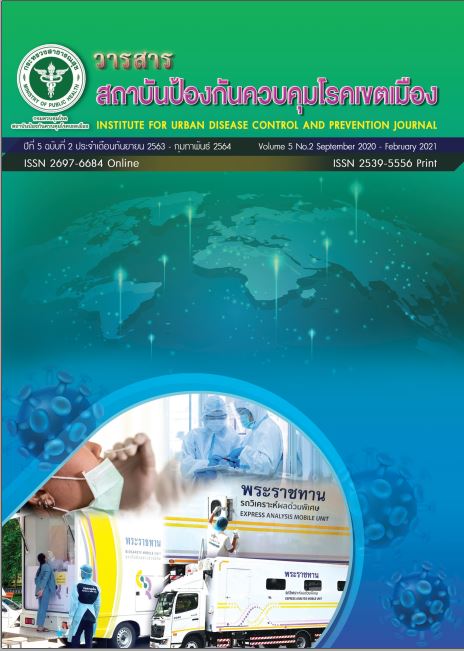การประเมินผลการแก้ไขปัญหาโรคไม่ติดต่อด้วยกลไกการพัฒนาคุณภาพชีวิตระดับอำเภอ อำเภอเทพสถิต จังหวัดชัยภูมิ
Main Article Content
บทคัดย่อ
การศึกษาครั้งนี้เป็นการประเมินผล เพื่อประเมินผลการแก้ไขปัญหาโรคไม่ติดต่อด้วยกลไกคณะกรรมการพัฒนาคุณภาพชีวิตระดับอำเภอ โดยการสุ่มกลุ่มตัวอย่างแบบเจาะจง จากคณะกรรมการ พชอ. ประชาชนในพื้นที่ 5 ตำบล จำนวน 44 คน เครื่องมือที่ใช้ในการศึกษา คือ แบบสัมภาษณ์รายบุคคล โครงสร้างเป็นคำถามแบบตัวเลือก โดยรายละเอียดแบ่งออกเป็น 2 ส่วน ดังนี้ ส่วนที่ 1 ข้อมูลทั่วไป ส่วนที่ 2 การประเมินผลการดำเนินงานโครงการโดยแบ่งเป็น 4 ด้านผล
การศึกษาพบว่าผู้ตอบแบบสอบถามเป็นประชาชนในพื้นที่ ร้อยละ 63 อายุเฉลี่ย 46 ปี มีบทบาทหน้าที่เกี่ยวกับระบบ/การดูแลสุขภาพในชุมชน ร้อยละ 75 ด้านบริบท พบว่า มีการดำเนินงานอยู่ในระดับปานกลาง (Mean = 3.38 , S.D. = 0.15) ข้อที่มีค่าเฉลี่ยมากที่สุดคือ ความสอดคล้องของวัตถุประสงค์โครงการฯกับนโยบายขององค์กรท่าน ด้านปัจจัยนำเข้า พบว่า มีการดำเนินงานอยู่ในระดับปานกลาง (Mean = 3.38, S.D. = 0.13) ข้อที่มีค่าเฉลี่ยมากที่สุด คือ ความรู้ความเข้าใจของท่านเกี่ยวกับวัตถุประสงค์ ขั้นตอน กระบวนการและแนวปฏิบัติในการดำเนินงาน ด้านกระบวนการ พบว่า มีการดำเนินงานอยู่ในระดับปานกลาง (Mean = 3.32, S.D. = 0.14) ข้อที่มีค่าเฉลี่ยมากที่สุด คือ กิจกรรมโครงการนำไปปฏิบัติได้จริง ด้านผลผลิต พบว่า มีการดำเนินงานอยู่ในระดับปานกลาง (Mean = 3.27, S.D. = 0.16) ข้อที่มีค่าเฉลี่ยมากที่สุด คือการนำผลการประเมินมาพัฒนาการจัดกิจกรรมการเรียนรู้อย่างต่อเนื่อง สรุป: การแก้ไขปัญหาโรคไม่ติดต่อด้วยกลไกคณะกรรมการพัฒนาคุณภาพชีวิตระดับอำเภอภาพรวมอยู่ในระดับปานกลาง มีการเริ่มดำเนินการกลไก พชอ. ในช่วงเวลา 2-3 ปี พบปัญหาการแต่งตั้งคณะกรรมการ ขาดผู้นำที่เข้มแข็ง ซึ่งเป็นปัจจัยหลักของการขับเคลื่อนนโยบาย กระบวนการดําเนินงานส่วนใหญ่เกิดจากหน่วยงานภาครัฐ และยังขาดการนิเทศ ติดตาม กำกับการดำเนินตามขั้นตอน และประเมินผลการอย่างเป็นระบบ
Article Details
บทความที่พิมพ์ในวารสารสถาบันป้องกันควบคุมโรคเขตเมือง ถือว่าเป็นผลงานวิชาการ งานวิจัยและวิเคราะห์ ตลอดจนเป็นความเห็นส่วนตัวของผู้เขียนเอง ไม่ใช่ความเห็นของสถาบันป้องกันควบคุมโรคเขตเมือง หรือคณะบรรณาธิการแต่ประการใด ผู้เขียนจำต้องรับผิดชอบต่อบทความของตน
เอกสารอ้างอิง
2. บัณฑิต วรรณประพันธ์ และคณะ.รายงานการประเมินผลเชิงคุณภาพการนำนโยบายสู่การปฏิบัติ เรื่องอำเภอควบคุมโรคเข้มแข็งแบบยั่งยืนในพื้นที่ สาธารณสุขเขต 14 ปี 2554. นครราชสีมา:มปท; 2555.
3. ณรงศักดิ์ หนูสอน และคณะ. รูปแบบการจัดการระบบสุขภาพระดับอำเภอเพื่อมุ่งสู่ อำเภอสร้างเสริมสุขภาพในเขตสุขภาพที่ 2 และเขตสุขภาพที่ 3.วารสารวิชาการมหาวิทยาลัยอีสเทิร์นเอเชีย .2561; ฉบับที่ 1 : หน้า 231-244.
4. ประเสริฐ โพธิ์มี.การประเมินการขับเคลื่อนยุทธศาสตร์การปฏิรูประบบสุขภาพ: ประเด็นการพัฒนาระบบสุขภาพระดับอำเภอ จังหวัดอุทัยธานี. วารสารสถาบันบำราศนราดูร.2562; ปีที่ 13 ฉบับที่ 3 กันยายน - ธันวาคม 2562 :หน้า 128-136.
5. ศรีเรือน ดีพูน. ประสิทธิผลของกลไกคณะกรรมการพัฒนาคุณภาพชีวิตและระบบ สุขภาพระดับอำเภอ ในพื้นที่นําร่อง อำเภอขุนหาญ จังหวัดศรีสะเกษ . วารสารการพัฒนาสุขภาพชุมชน มหาวิทยาลัยขอนแก่น .2562; ปีที่ 7 ฉบับที่ 2 เมษายน – มิถุนายน 2562 : หน้า 263-281.
6. แววดี เหมวรานนท์. การประเมินผลการดำเนินงานคณะกรรมการพัฒนาคุณภาพชีวติระดับอำเภอ จังหวัดนครราชสีมา.วราสารวิจัยและพัฒนาด้านสุขภาพ สำนักงานสารณสุขจังหวัดนครราชสีมา. 2563; ปีที่ 6 ฉบับที่ 1 ; หน้า 140-157.
7. ศรีสุนทร วิริยะวิภาต และคณะ. การประเมินผลนโยบายต่อการขับเคลื่อนโครงการอำเภอควบคุมโรค เข้มแข็งแบบยั่งยืนในพื้นที่ของ สำนักงานป้องกันควบคุมโรคที่ 6 จังหวัดขอนแก่น ปีงบประมาณ 2555. วราสารสำนักงานป้องกันควบคุมโรคที่ 6 ขอนแก่น. 2555; ปีที่ 19 ฉบับที่ 2 เมษายน - กันยายน 2555 : หน้า 84-99.


